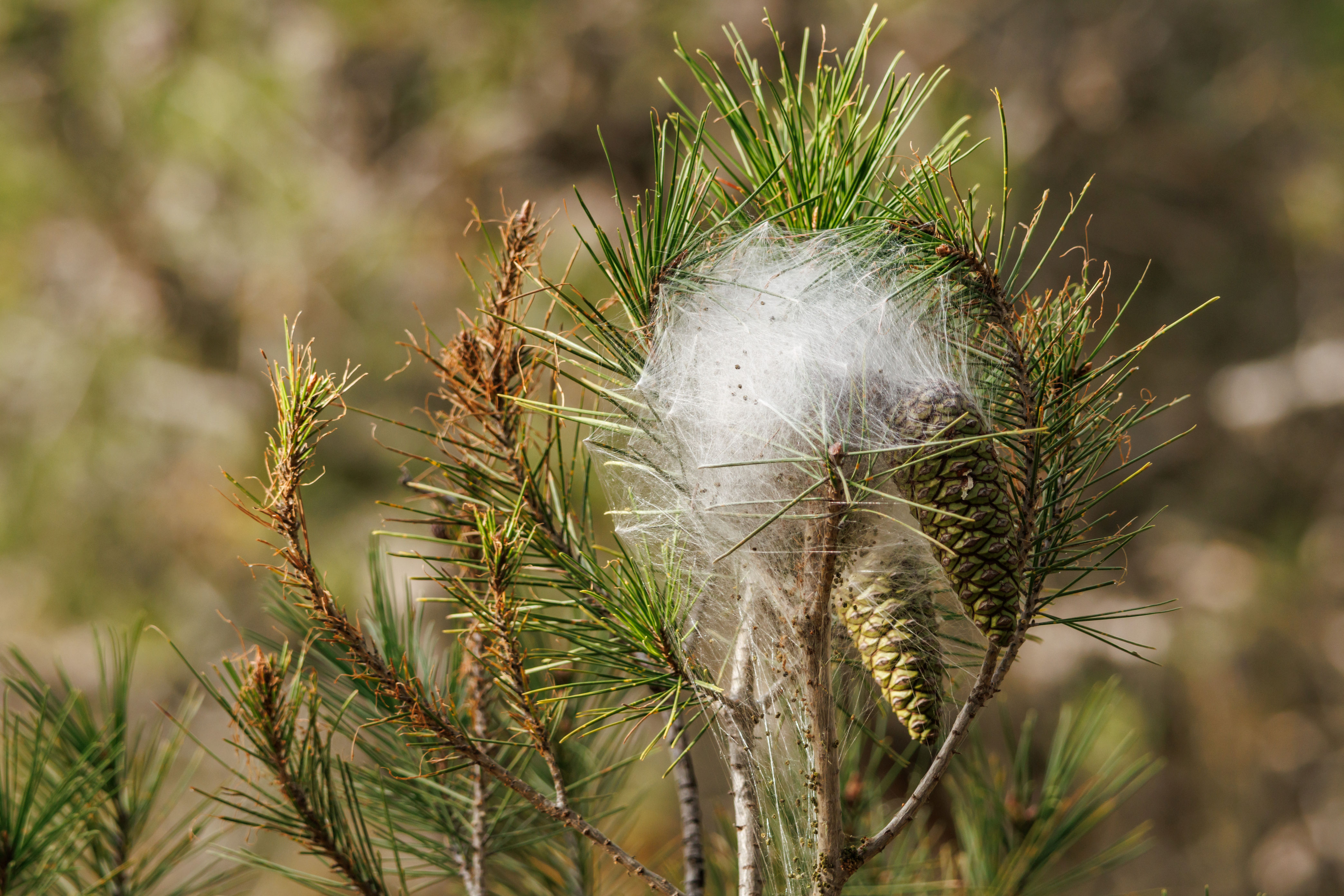The processionary is already on the way, people and animals at risk: how to recognize it and how to protect your dog

Due to climate change this year he appeared in advance. His stinging hair can cause necrosis of the tongue, respiratory troubles and also lead to death. All the precautions to be adopted and what to do in the event of an emergency
Processionary, what a cross! In advance of the more classic Easter processions, here to parade first, thanks to the global warming that accelerates the beginning of the season, are the « processions« Of Thaumetopoea Pityocamppathe Pine processionaryarthropod of the order of lepidoptera, widespread in Eurasia and North Africa. It is an insect Not only destructive for the pine forests due to its defogliant effect, but also dangerous for people and animals.
I am Four phases of its life cycle – egg, larva or caterpillar, chrysalis, butterfly – but, if As an adult it turns into an harmless moth, during the larval stadium it presents a poisonous stingy hairAnd. For the hairy appearance it is easy to recognize when it is caterpillar – between 3 and 4 cm long, with the black leader, while the body is gray on the sides and facing on the back -, unmistakable during the movements, in an Indian rowwhile it forms a « procession« from which its vulgar name derives. This is why and how to protect your dogs.
Punctual, indeed in advance
Higher temperatures of the seasonal average can anticipate the vegetative recovery and, with it, the movement of these larvae. Usually active in the spring, thanks to global warming, these procession caterpillars have already recorded since February and these days they have been making more and more road between the paths. During the beautiful days, The larvae descend from the branches where the nests are located To head towards the ground in search of Suitable place to wait for the metamorphosis at the adult stageand it is from the ground that, intrigued, dogs and children can try to collect them. Very dangerous for man, they can prove to be lethal for his best friends: whoever in this period frequent parks, gardens and woods should stay away from it, avoiding to get in touch not only on a tactile level, avoiding the contamination of skin and, above all, mucous membranes; The hair is harmful, in fact, even if inhaled, causing coughing and breathing difficulties in both species, human and canine.
Which plants host them
The (ugly) surprises do not come, however, only from pinesbut also from oak (in this case we talk about Thaumetopoea Processionaa): greater attention will therefore be paid during the walks with your dog in areas where these arboreal types could stand. But if life cycle and danger of the oak processionary are similar to those of the pine processionary, the phenomenon does not circumscribe here: in fact, there are even forty different species that parasitic different plantsin any case, preferring the younger ones. More rarely, they can also infest chestnuts, birch, larch, fir And beecheven colonizing i cedars of certain urban areas, therefore be careful also in the city. The hair of the trees must be observed and, if you notice the trace of White nests similar to cobwebssuspended between the branches, avoid the area and report it to the Municipality to provide for disinfestation.
What causes in humans and animals
THE stinging hair who cover the body of the larva, released in the air when the caterpillar feels in danger and widespread even by the wind, they are poisonous to humans and animals: sometimes, they can cause an important allergic reaction which, in case of repeated contacts, also induces anaphylactic shock with mortal danger (Among the symptoms: urticaria, sweating, Edema of mouth and throat, respiratory difficulties, hypotension And loss of consciousness). They are thin, pointed and hooked: penetrating the skin and breaking, they cause skin reactions that manifest themselves as apainful and itchy eruption.
In contact with the human and canine mucous membranes, they trigger one irritative and inflammatory reaction because it contains a protein, the traumatoproteinwhich induces liberation of histamine, mediator of inflammation. The symptomatological picture is therefore complicated in the event that the hair is ingested (Lingual edema with ulcers, inflammation of mouth and gastrointestinal mucosa with hypersalivation, vomiting and abdominal pain with diarrhea) or inhaled (Irritation and inflammation of the airways with sneezing, coughs, difficulty of swallowing and respiratory). Added fever, loss of liveliness And anorexia for inflammation of the buccal and languages mucous membranes. In the most serious cases, the severity of the inflammatory process can lead to necrosis of entire portions of the languagewith mutilations of the offended parts.

Prevent it is better than urinating
In addition to the observation of the hair of the trees and paths that you travel with your dogs, also pay attention to the cortex of plants: The caterpillars camouflage themselves well until they walk along the trunks, to which dogs tend to approach to mark. To avoid losing the view on the dog and what it could collect from the ground, It should not be released in risk environmentsbut manage it to the Lunghina – a long ad hoc rope – or with the so -called leash flexi – the rewindable one -,, Keeping the closest subject to cross the critical points. The same dog areas where you can free your friends more safely should be inspected and reclaimed first. A poisoned anti -bite muzzle It can prevent the dog from caught the caterpillar but, in any case, it cannot prevent it from smelling and, in case, inhale the stinging and poisonous hair that, in addition to inducing serious allergic reactions in some cases, we have seen how it can give a very complicated clinical picture, which can lead to a necrosis of the tissues affected, primarily those of the tongue.
No hair on the tongue: what to do in case of contact
Managed the offended dog carefully, which must be immediately shifted to the place where it was affected by the processionary – it is in fact probable there are others nearby – and handled with care, remaining vigilant against his involuntary pain reactions. Always bring with you a couple of latex glovesFor Do not touch the larva with bare handsmaybe even of the tweezersfor a more punctual removal of the hair, and a bottle of water, preferably with a spout cap like that of sports drinks, useful to enhance the jet and optimize the direction: if the dog should take the caterpillar in the mouth, wash it immediately abundantly (better if there is an addition of bicarbonate to the water), be careful that the drain to fluctate the external, to avoid involving other parts of the body and operating in a way. The animal did not drink.
Emergency protocol
As is not recommended in the presence of sharp foreign bodies, sharp, hooked or ribbed, as well as caustic substances, induce vomiting in case of ingestion of a processionary may not be recommendedbecause the hair would risk harming the anatomical districts already crossed. Whether the dog has swallowed the caterpillar or not, Alerted the clinic closest to you immediately and reach it with the utmost urgency to limit the damage as much as possible. Do not waste time, persisting to contact the clinic that you frequent usually: in these cases, He counts first of all timeliness.
To your trusted professional, however, you can ask for useful Preventive information: self -medication tendentially not recommended, but the veterinarian can establish that some life -saving drugs, such as the cortisone In case of anaphylactic risk, they can be indicated for a emergency kit. He will, however, advise you which, in what dosages and in what circumstances should be used for your friend, always and only to buffer an emergency situation, waiting for specialist care. Attend a first aid course in which to learn to face this and other possibilities is certainly always Recommended for anyone with a dog And he wants to protect his health.





